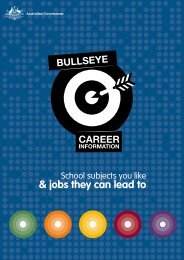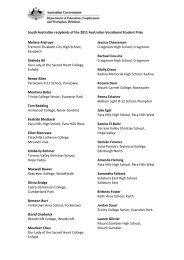Belonging, Being and Becoming - Early Years Learning Framework
Belonging, Being and Becoming - Early Years Learning Framework
Belonging, Being and Becoming - Early Years Learning Framework
You also want an ePaper? Increase the reach of your titles
YUMPU automatically turns print PDFs into web optimized ePapers that Google loves.
PRACTICE<br />
PRACTICE<br />
The principles of early childhood pedagogy<br />
underpin practice. Educators draw on a rich<br />
repertoire of pedagogical practices to promote<br />
children’s learning by:<br />
• adopting holistic approaches<br />
• being responsive to children<br />
• planning <strong>and</strong> implementing learning through play<br />
• intentional teaching<br />
• creating physical <strong>and</strong> social learning<br />
environments that have a positive impact on<br />
children’s learning<br />
• valuing the cultural <strong>and</strong> social contexts of<br />
children <strong>and</strong> their families<br />
• providing for continuity in experiences <strong>and</strong><br />
enabling children to have successful transition<br />
• assessing <strong>and</strong> monitoring children’s learning<br />
to inform provision <strong>and</strong> to support children in<br />
achieving learning outcomes.<br />
Holistic approaches<br />
Holistic approaches to teaching <strong>and</strong> learning<br />
recognise the connectedness of mind, body <strong>and</strong><br />
spirit 4 . When early childhood educators take a<br />
holistic approach they pay attention to children’s<br />
physical, personal, social, emotional <strong>and</strong> spiritual<br />
wellbeing as well as cognitive aspects of learning.<br />
While educators may plan or assess with a focus<br />
on a particular outcome or component of learning,<br />
they see children’s learning as integrated <strong>and</strong><br />
interconnected. They recognise the connections<br />
BECOMING<br />
14 BELONGING, BEING & BECOMING The <strong>Early</strong> <strong>Years</strong> <strong>Learning</strong> <strong>Framework</strong> for Australia<br />
LEARNING OUTCOMES<br />
BELONGING<br />
CHILDREN’S<br />
LEARNING<br />
PRACTICE<br />
PRINCIPLES<br />
between children, families <strong>and</strong> communities <strong>and</strong><br />
the importance of reciprocal relationships <strong>and</strong><br />
partnerships for learning. They see learning as a<br />
social activity <strong>and</strong> value collaborative learning <strong>and</strong><br />
community participation.<br />
An integrated, holistic approach to teaching <strong>and</strong><br />
learning also focuses on connections to the natural<br />
world. Educators foster children’s capacity to<br />
underst<strong>and</strong> <strong>and</strong> respect the natural environment<br />
<strong>and</strong> the interdependence between people, plants,<br />
animals <strong>and</strong> the l<strong>and</strong>.<br />
Responsiveness to children<br />
Educators are responsive to all children’s strengths,<br />
abilities <strong>and</strong> interests. They value <strong>and</strong> build on<br />
children’s strengths, skills <strong>and</strong> knowledge to ensure<br />
their motivation <strong>and</strong> engagement in learning. They<br />
respond to children’s expertise, cultural traditions<br />
<strong>and</strong> ways of knowing, the multiple languages spoken<br />
by some children, particularly Aboriginal <strong>and</strong> Torres<br />
Strait Isl<strong>and</strong>er children, <strong>and</strong> the strategies used by<br />
children with additional needs to negotiate their<br />
every day lives.<br />
Scaffold:<br />
the educators’ decisions <strong>and</strong> actions that<br />
build on children’s exisitng knowledge <strong>and</strong><br />
skills to enhance their learning.<br />
4 Siraj-Blatchford, I., & Sylva, K. (2004). Researching pedagogy in English pre-schools. British Educational Research Journal, 30(5), 712-730.<br />
BEING





